Examples of Rupture Patterns of the 2023, Mw 7.8 Kahramanmaraş Surface-Faulting Earthquake, Türkiye
Abstract
1. Introduction
2. Background

3. Materials and Methods
3.1. Remote Rupture Line Drawing

3.2. Fieldwork
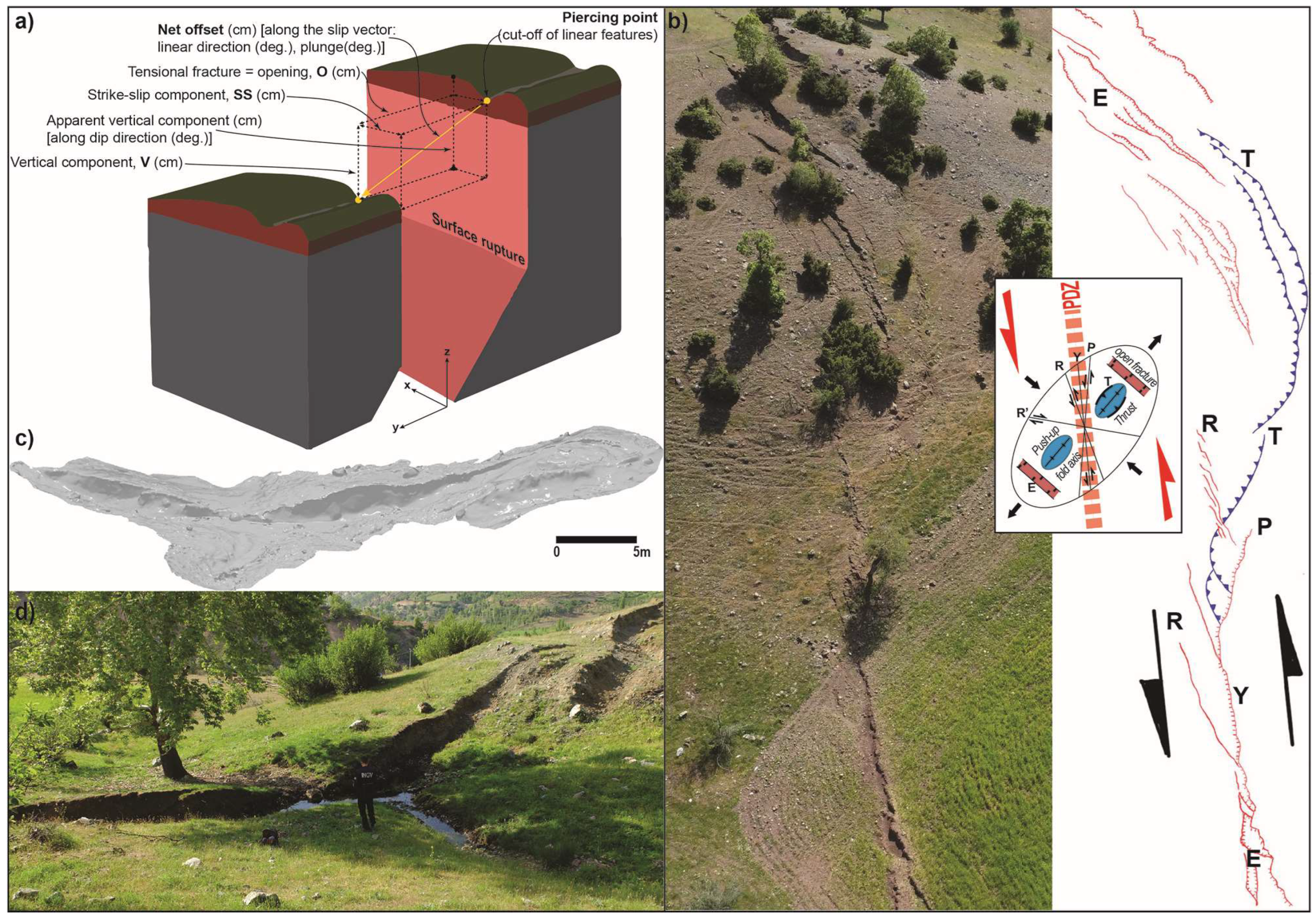
4. Results
4.1. Coseismic Rupture Reconstruction: Small-Scale Characteristics


4.2. The Gölbaşı Railway Deflections
4.3. Coseismic Rupture: Outcrop Scale Documentation
4.3.1. Key Area: Bademli, Nurdağı District
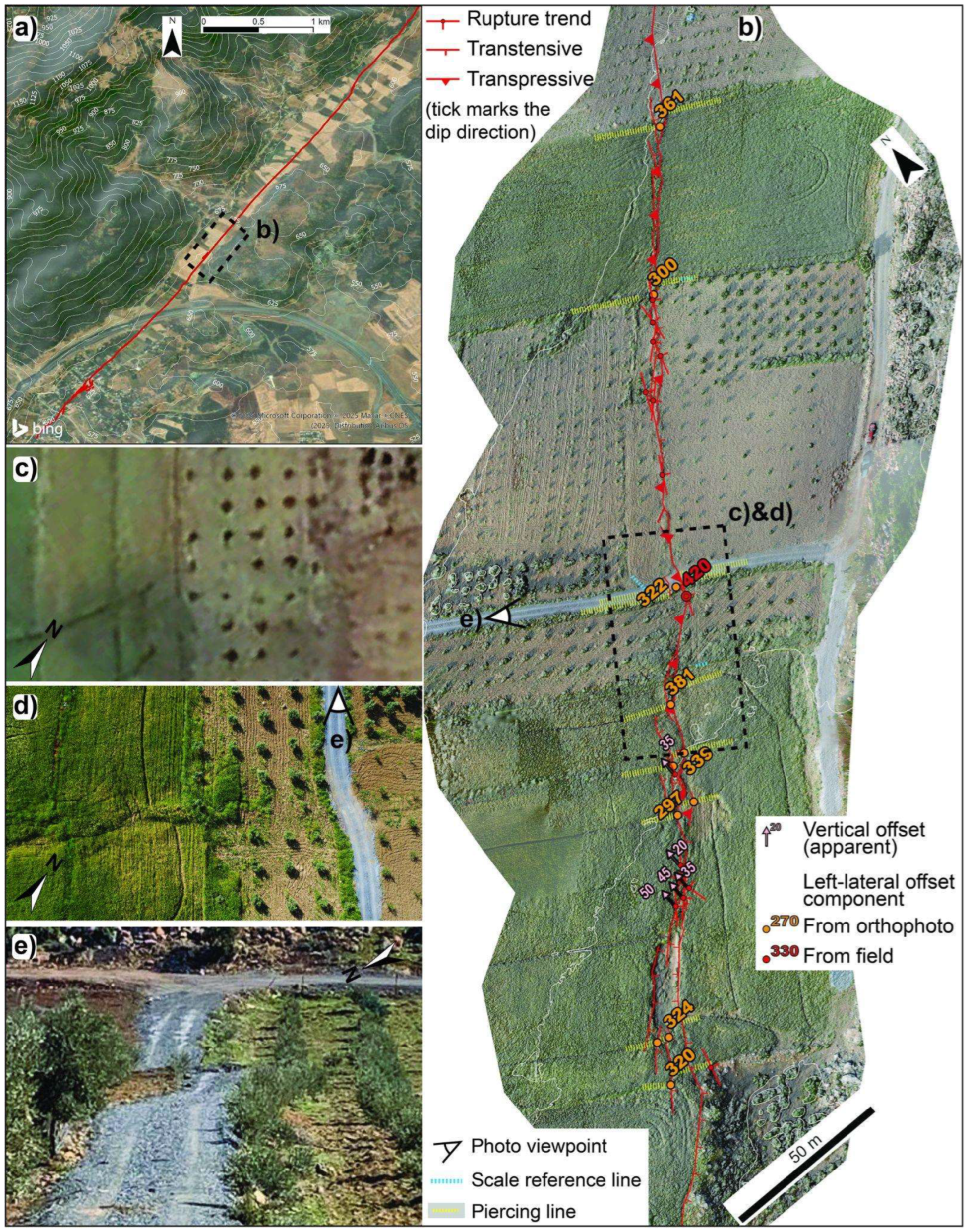
4.3.2. Key Area: Tevekkelli, Kahramanmaraş District
4.3.3. Key Area: South Kartal, Kahramanmaraş District

4.3.4. Key Area: East Kartal, Kahramanmaraş District
4.3.5. Key Area: Kısık, Pazarcık District
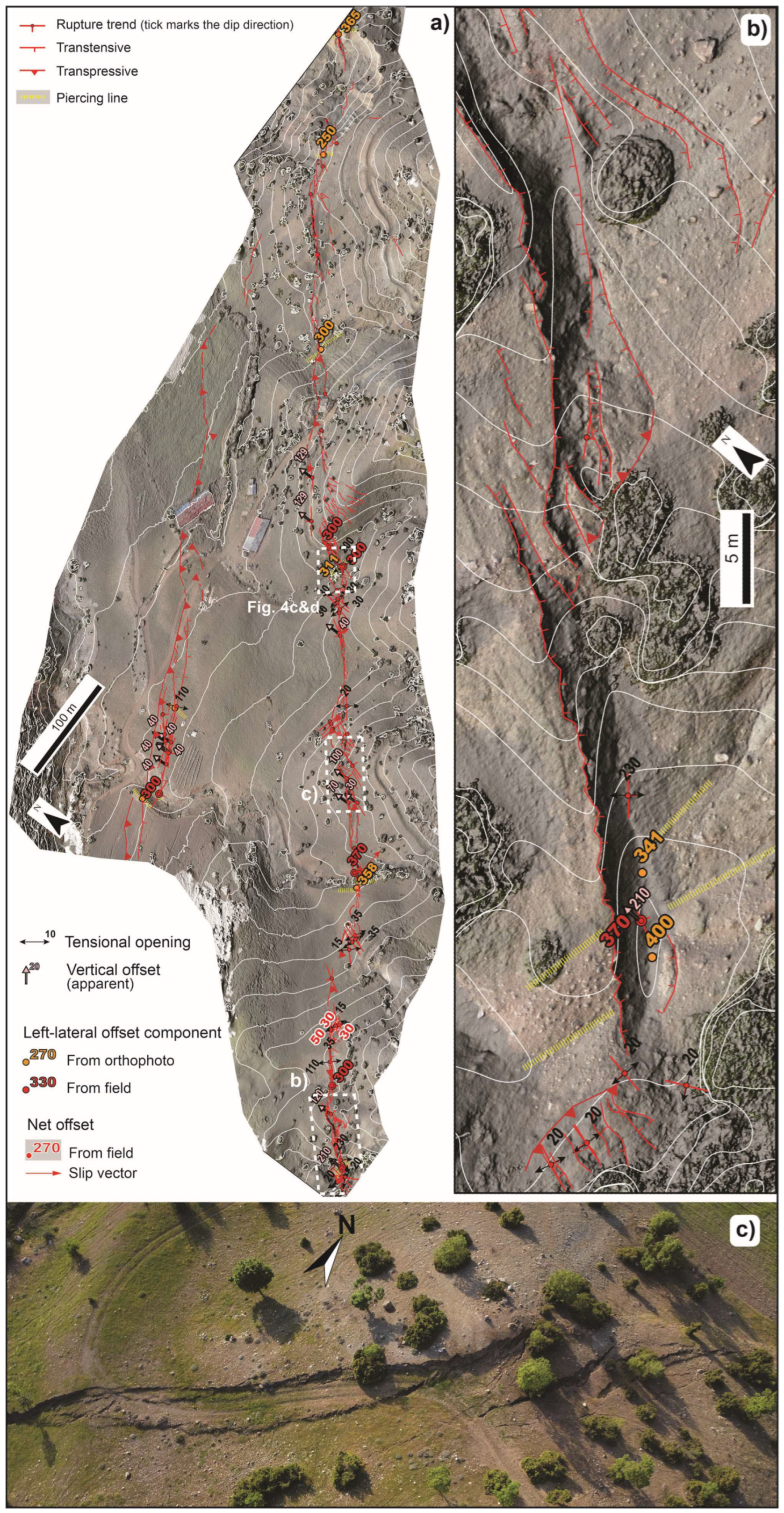
4.3.6. Key Area: Harmanlı, Gölbaşı District
5. Discussion
5.1. Integrating the Coseismic Slip Distribution Curve
5.2. Comparing the Surface and Deep Rupture
5.3. Structural Style Distribution Along the Rupture Trace
5.4. Coseismic Rupture Patterns: General Considerations
5.5. Recurrence Time Speculations
6. Conclusions
Supplementary Materials
Author Contributions
Funding
Data Availability Statement
Acknowledgments
Conflicts of Interest
Abbreviations
| AFAD | Disaster and Emergency Management Authority of Türkiye |
| USGS | United States Geological Surveys |
| OAM | OpenAerialMap |
| ALOS | Advanced Land Observing Satellite |
| GNSS | Global Navigation Satellite System (USA) |
| GPS | Global Positioning System |
| GLONASS | GLObal NAvigation Satellite System (Russia) |
| MTA | General Directorate of Mineral Research and Exploration |
| InSAR | Interferometric Synthetic Aperture Radar |
| EAFZ | East Anatolian Fault Zone |
| EuQuaGe | European Earthquake Geology Task Force |
| PDZ | Principal Displacement Zone |
| SDZ | Single Displacement Zone |
| DEM | Digital Elevation Model |
| DSM | Digital Surface Model |
| RTK | Real-Time Kinematic |
| DSLR | Digital Single-Lens Reflex |
| CMOS | Complementary Metal-Oxide-Semiconductor |
| OS | Operative System |
| IMU | Inertial Measurement Unit |
| LIDAR | Light Detection and Ranging |
| GIS | Geographic Information System |
| SfM | Structure-from-Motion |
Appendix A
Appendix B

References
- Nurminen, F.; Baize, S.; Boncio, P.; Blumetti, A.M.; Cinti, F.R.; Civico, R.; Guerrieri, L. SURE 2.0—New release of the worldwide database of surface ruptures for fault displacement hazard analyses. Sci. Data 2022, 9, 729. [Google Scholar] [CrossRef] [PubMed]
- Wells, D.L.; Coppersmith, K.J. New empirical relationships among magnitude, rupture length, rupture width, rupture area, and surface displacement. Bull. Seismol. Soc. Am. 1994, 84, 974–1002. [Google Scholar] [CrossRef]
- Wesnousky, S.G. Displacement and geometrical characteristics of earthquake surface ruptures: Issues and implications for seismic-hazard analysis and the process of earthquake rupture. Bull. Seismol. Soc. Am. 2008, 98, 1609–1632. [Google Scholar] [CrossRef]
- Thingbaijam, K.K.S.; Mai, P.M.; Goda, K. New empirical earthquake source-scaling laws. Bull. Seismol. Soc. Am. 2017, 107, 2225–2246. [Google Scholar] [CrossRef]
- Shaw, B.E. Magnitude and slip scaling relations for fault-based seismic hazard. Bull. Seismol. Soc. Am. 2023, 113, 924–947. [Google Scholar] [CrossRef]
- Mai, P.M.; Thingbaijam, K.K.S. SRCMOD: An online database of finite-fault rupture models. Seismol. Res. Lett. 2014, 85, 1348–1357. [Google Scholar] [CrossRef]
- Guerrieri, L.; Michetti, A.M.; Silva, P.G. EEE Catalogue: A Global Database of Earthquake Environmental Effects. In Encyclopedia of Earthquake Engineering; Beer, M., Kougioumtzoglou, I.A., Patelli, E., Au, S.K., Eds.; Springer: Berlin/Heidelberg, Germany, 2015. [Google Scholar] [CrossRef]
- DuRoss, C.B.; Reitman, N.G.; Hatem, A.E.; Mason, H.B.; Lavrentiadis, G.; Asimaki, D.; Milliner, C.; Karakaş, M.; Seçen, B. Are Field Observations of Surface Rupture Useful? An Example from the 2023 Mw 7.8 Pazarcık, Turkey (Türkiye). Earthq. Seismol. Res. Lett. 2024, 96, 848–867. [Google Scholar] [CrossRef]
- Caglayan, A.; Isik, V.; Saber, R.; Unal, H.; Chitea, F. Analysis of surface rupture patterns and fault offset variability associated with the 06 February 2023 Pazarcik (Kahramanmaras) earthquake (mw 7.7) in Islahiye area, Turkiye. In Proceedings of the Eurasia Geoscience Congress and Exhibition, Antalya, Turkey, 10–13 November 2023; pp. 19–24. [Google Scholar]
- Gokceoglu, C. 6 February 2023 Kahramanmaraş–Türkiye earthquakes: A general overview. Int. Arch. Photogramm. Remote Sens. Spat. Inf. Sci. 2023, 48, 417–424. [Google Scholar] [CrossRef]
- Karabacak, V.; Özkaymak, Ç.; Sözbilir, H.; Tatar, O.; Aktuğ, B.; Özdağ, Ö.C.; Çakir, R.; Aksoy, E.; Koçbulut, F.; Softa, M.; et al. The 2023 Pazarcık (Kahramanmaraş, Türkiye) earthquake (Mw 7.7): Implications for surface rupture dynamics along the East Anatolian fault zone. J. Geol. Soc. 2023, 180, jgs2023-020. [Google Scholar] [CrossRef]
- Kürçer, A.; Elmacı, H.; Özdemir, E.; Güven, C.; Güler, T.; Avcu, İ.; Olgun, Ş.; Avcı, H.O.; Aydoğan, H.; Yüce, A.A.; et al. 06 Şubat 2023 Pazarcık (Kahramanmaraş) Depremi (Mw 7.7) Saha Gözlemleri ve Değerlendirmeler. MTA Genel Müdürlüğü, Rapor No: 14138, 2023, 187 s., Ankara. Available online: https://www.mta.gov.tr/v3.0/sayfalar/bilgi-merkezi/deprem/pdf/14138.pdf (accessed on 20 June 2025).
- Duman, T.Y.; Emre, Ö. The East Anatolian Fault: Geometry, segmentation and jog characteristics. Geol. Soc. Spec. Publ. 2013, 372, 495–529. [Google Scholar] [CrossRef]
- AFAD. 06 Şubat 2023 Pazarcik (Kahramanmaraş) Mw 7.7 Elbistan (Kahramanmaraş) Mw 7.6 Depremlerine İlişkin Ön Değerlendirme Raporu. Earthquake Department, ed. Report (In Turkish). 2023. Available online: https://deprem.afad.gov.tr/assets/pdf/Kahramanmara%C5%9F%20Depremi%20%20Raporu_02.06.2023.pdf (accessed on 20 June 2025).
- United States Geological Survey (USGS). M 7.8—Pazarcik Earthquake, Kahramanmaras Earthquake Sequence. National Earthquake Information Center (6 February 2023). 2023. Available online: https://earthquake.usgs.gov/earthquakes/eventpage/us6000jllz/executive (accessed on 20 June 2025).
- Reilinger, R.; McClusky, S.; Vernant, P.; Lawrence, S.; Ergintav, S.; Cakmak, R.; Ozener, H.; Kadirov, F.; Guliev, I.; Stepanyan, R.; et al. GPS constraints on continental deformation in the Africa–Arabia–Eurasia continental collision zone and implications for the dynamics of plate interactions. J. Geophys. Res. Solid Earth 2006, 111, B05411. [Google Scholar] [CrossRef]
- Dewey, J.F.; Hempton, M.R.; Kidd, W.S.F.; Saroglu, F.A.M.C.; Şengör, A.M.C. Shortening of continental lithosphere: The neotectonics of Eastern Anatolia—A young collision zone. Geol. Soc. Spec. Publ. 1986, 19, 1–36. [Google Scholar] [CrossRef]
- McKenzie, D.P. Active tectonics of the Mediterranean region. Geophys. J. R. Astron. Soc. 1972, 30, 109–185. [Google Scholar] [CrossRef]
- Şengör, A.C.; Yilmaz, Y. Tethyan evolution of Turkey: A plate tectonic approach. Tectonophysics 1981, 75, 181–241. [Google Scholar] [CrossRef]
- Westaway, R. Kinematics of the Middle East and Eastern Mediterranean Updated. Turk. J. Earth Sci. 2003, 12, 5–46. [Google Scholar]
- Westaway, R.; Demir, T.; Seyrek, A.; Beck, A. Kinematics of Active Left lateral Faulting in SE Turkey from Offset Pleistocene River Gorges: Improved Constraint on the Rate and History of Relative Motion between the Turkish and Arabian Plates. J. Geol. Soc. 2006, 163, 149–164. [Google Scholar] [CrossRef]
- Weiss, J.R.; Walters, R.J.; Morishita, Y.; Wright, T.J.; Lazecky, M.; Wang, H.; Hussain, E.; Hooper, A.J.; Elliott, J.R.; Rollins, C.; et al. High-resolution surface velocities and strain for Anatolia from sentinel-1 InSAR and GNSS data. Geophys. Res. Lett. 2020, 47, e2020GL087376. [Google Scholar] [CrossRef]
- Barka, A.A.; Kadinsky-Cade, K. Strike-slip fault geometry in Turkey and influence on earthquake activity. Tectonics 1988, 7, 663–684. [Google Scholar] [CrossRef]
- Tatar, O.; Sözbilir, H.; Koçbulut, F.; Bozkurt, E.; Aksoy, E.; Eski, S.; Özmen, B.; Alan, H.; Metin, Y. Surface deformations of 24 January 2020 Sivrice (Elazığ)–Doğanyol (Malatya) earthquake (Mw = 6.8) along the Pütürge segment of the East Anatolian Fault Zone and its comparison with Turkey’s 100-year-surface ruptures. Mediterr. Geosci. Rev. 2020, 2, 385–410. [Google Scholar] [CrossRef]
- Ambraseys, N.N.; Jackson, J.A. Faulting associated with historical and recent earthquakes in the Eastern Mediterranean region. Geophys. J. Int. 1998, 133, 390–406. [Google Scholar] [CrossRef]
- Tan, O.; Tapırdamaz, M.C.; Yörük, A. The earthquake catalogues for Turkey. Turk. J. Earth Sci. 2008, 17, 405–418. [Google Scholar]
- Bulut, F.; Bohnhoff, M.; Eken, T.; Janssen, C.; Kılıç, T.; Dresen, G. The East Anatolian Fault Zone: Seismotectonic setting and spatiotemporal characteristics of seismicity based on precise earthquake locations. J. Geophys. Res. Solid Earth 2012, 117, B07304. [Google Scholar] [CrossRef]
- Stucchi, M.; Şeşetyan, K.; Castelli, V.; Capera, A.A.G.; Meletti, C.; Sbeinati, M.R. About the “predecessors” of the 2023 February earthquakes, Turkey. Seismica 2024, 2. [Google Scholar] [CrossRef]
- Castelli, V.; Stucchi, M. The hypothesis of the 1513/1514 very large earthquake in the East Anatolian Fault Zone: Rise and weakness. J. Seismol. 2025. [Google Scholar] [CrossRef]
- Çetin, H.; Güneyli, H.; Mayer, L. Paleoseismology of the Palu-Lake Hazar segment of the East Anatolian Fault Zone, Turkey. Tectonophysics 2003, 374, 163–197. [Google Scholar] [CrossRef]
- Yüksel, Ö. Gölbaşı (Adıyaman) Dolayında Doğu Anadolu Fay Sistemi’nin Paleosismisitesi ve Zeminlerin Değerlendirilmesi. Master’s Thesis, Çukurova University, Institute of Applied Science, Adana, Turkey, 2009. [Google Scholar]
- Palutoğlu, M.; Şaşmaz, A. 29 November 1795 Kahramanmaraş Earthquake, Southern Turkey. Bull. Miner. Res. Explor. 2017, 155, 187–202. [Google Scholar] [CrossRef][Green Version]
- Carena, S.; Friedrich, A.M.; Verdecchia, A.; Kahle, B.; Rieger, S.; Kübler, S. Identification of source faults of large earthquakes in the Turkey-Syria Border Region between 1000 CE and the present, and their relevance for the 2023 Mw 7.8 Pazarcık earthquake. Tectonics 2023, 42, e2023TC007890. [Google Scholar] [CrossRef]
- Ding, H.; Zhou, Y.; Ge, Z.; Taymaz, T.; Ghosh, A.; Xu, H.; Irmak, T.S.; Song, X. High-resolution seismicity imaging and early aftershock migration of the 2023 Kahramanmaraş (SE Türkiye) MW 7. 9 & 7.8 earthquake doublet. Earthq. Sci. 2023, 36, 417–432. [Google Scholar] [CrossRef]
- Harzali, M.; Medhioub, E.; Abdelmalak, M.M.; Hamdouni, A.; Troudi, H. Insights from the 06 February 2023 Mw 7.8 Kahramanmaras earthquake: Evidence into an active strike-slip faulting along the East Anatolian Fault Zone. Acta Geod. Geophys. 2023, 58, 465–497. [Google Scholar] [CrossRef]
- Kwiatek, G.; Martínez-Garzón, P.; Becker, D.; Dresen, G.; Cotton, F.; Beroza, G.C.; Bohnhoff, M. Months-long seismicity transients preceding the 2023 MW 7.8 Kahramanmaraş earthquake, Türkiye. Nat. Commun. 2023, 14, 7534. [Google Scholar] [CrossRef]
- Okuwaki, R.; Yagi, Y.; Taymaz, T.; Hicks, S.P. Multi-scale rupture growth with alternating directions in a complex fault network during the 2023 south-eastern Türkiye and Syria earthquake doublet. Geophys. Res. Lett. 2023, 50, e2023GL103480. [Google Scholar] [CrossRef]
- Tikhotsky, S.A.; Tatevosyan, R.E.; Rebetsky, Y.L.; Ovsyuchenko, A.N.; Larkov, A.S. The 2023 Kahramanmaraş earthquakes in Turkey: Seismic movements along conjugated faults. Dokl. Earth Sci. 2023, 511, 703–709. [Google Scholar] [CrossRef]
- Alkan, H.; Büyüksaraç, A.; Bektaş, Ö. Investigation of earthquake sequence and stress transfer in the Eastern Anatolia Fault Zone by Coulomb stress analysis. Turk. J. Earth Sci. 2024, 33, 56–68. [Google Scholar] [CrossRef]
- Dai, X.; Liu, X.; Liu, R.; Song, M.; Zhu, G.; Chang, X.; Guo, J. Coseismic Slip Distribution and Coulomb Stress Change of the 2023 MW 7.8 Pazarcik and MW 7.5 Elbistan Earthquakes in Turkey. Remote Sens. 2024, 16, 240. [Google Scholar] [CrossRef]
- Toda, S.; Stein, R.S. The role of stress transfer in rupture nucleation and inhibition in the 2023 Kahramanmaraş, Türkiye, sequence, and a one-year earthquake forecast. Seismol. Res. Lett. 2024, 95, 596–606. [Google Scholar] [CrossRef]
- Demircioğlu, M.B.; Şeşetyan, K.; Duman, T.Y.; Can, T.; Tekin, S.; Ergintav, S. A probabilistic seismic hazard assessment for the Turkish territory: Part II—Fault source and background seismicity model. Bull. Earthq. Eng. 2018, 16, 3399–3438. [Google Scholar] [CrossRef]
- Jia, Z.; Jin, Z.; Marchandon, M.; Ulrich, T.; Gabriel, A.A.; Fan, W.; Fialko, Y. The complex dynamics of the 2023 Kahramanmaraş, Turkey, M w 7.8-7.7 earthquake doublet. Science 2023, 381, 985–990. [Google Scholar] [CrossRef] [PubMed]
- Reitman, N.G.; Briggs, R.W.; Barnhart, W.D.; Hatem, A.E.; Thompson Jobe, J.A.; DuRoss Gold, R.D.; Mejstrik, J.D.; Collett, C.; Koehler, R.D.; Akçiz, S. Rapid Surface Rupture Mapping from Satellite Data: The 2023 Kahramanmaraş, Turkey (Türkiye), Earthquake Sequence. Seism. Rec. 2023, 3, 289–298. [Google Scholar] [CrossRef]
- Gürboğa, Ş.; Kayadibi, Ö.; Akilli, H.; Arikan, S.; Tan, S. Preliminary results of the great Kahramanmaraş 6 February 2023 Earthquakes (MW 7.7 and 7.6) and 20 February 2023 Antakya Earthquake (MW 6.4), Eastern Türkiye. Turk. J. Earth Sci. 2024, 33, 22–39. [Google Scholar] [CrossRef]
- Goldberg, D.E.; Taymaz, T.; Reitman, N.G.; Hatem, A.E.; Yolsal-Çevikbilen, S.; Barnhart, W.D.; Altuntaş, C. Rapid characterization of the February 2023 Kahramanmaraş, Türkiye, earthquake sequence. Seism. Rec. 2023, 3, 156–167. [Google Scholar] [CrossRef]
- Gkougkoustamos, I.; Krassakis, P.; Kalogeropoulou, G.; Parcharidis, I. Correlation of Ground Deformation Induced by the 6 February 2023 M7. 8 and M7. 5 Earthquakes in Turkey Inferred by Sentinel-2 and Critical Exposure in Gaziantep and Kahramanmaraş Cities. GeoHazards 2023, 4, 267–285. [Google Scholar] [CrossRef]
- Guo, Y.; Li, H.; Liang, P.; Xiong, R.; Hu, C.; Xu, Y. Preliminary report of coseismic surface rupture (part) of Türkiye’s MW 7.8 earthquake by remote sensing interpretation. Earthq. Res. Adv. 2024, 4, 100219. [Google Scholar] [CrossRef]
- Kobayashi, T.; Munekane, H.; Kuwahara, M.; Furui, H. Insights on the 2023 Kahramanmaraş Earthquake, Turkey, from InSAR: Fault locations, rupture styles and induced deformation. Geophys. J. Int. 2024, 236, 1068–1088. [Google Scholar] [CrossRef]
- Ou, Q.; Lazecky, M.; Watson, C.S.; Maghsoudi, Y.; Wright, T. 3D Displacements and Strain from the 2023 February Turkey Earthquakes Version 1 [Dataset]. NERC EDS Centre for Environmental Data Analysis. Available online: https://catalogue.ceda.ac.uk/uuid/df93e92a3adc46b9a5c4bd3a547cd242/ (accessed on 20 June 2025).
- Provost, F.; Karabacak, V.; Malet, J.P.; Van der Woerd, J.; Meghraoui, M.; Masson, F.; Pointal, E. High-resolution co-seismic fault offsets of the 2023 Türkiye earthquake ruptures using satellite imagery. Sci. Rep. 2024, 14, 6834. [Google Scholar] [CrossRef] [PubMed]
- Özkan, A.; Solak, H.İ.; Tiryakioğlu, İ.; Şentürk, M.D.; Aktuğ, B.; Gezgin, C.; Yavaşoğlu, H.H. Characterization of the co-seismic pattern and slip distribution of the February 06, 2023, Kahramanmaraş (Turkey) earthquakes (Mw 7.7 and Mw 7.6) with a dense GNSS network. Tectonophysics 2023, 866, 230041. [Google Scholar] [CrossRef]
- Barbot, S.; Luo, H.; Wang, T.; Hamiel, Y.; Piatibratova, O.; Javed, M.T.; Gurbuz, G. Slip distribution of the February 6, 2023 Mw 7.8 and Mw 7.6, Kahramanmaraş, Turkey earthquake sequence in the East Anatolian fault zone. Seismica 2023, 2. [Google Scholar] [CrossRef]
- He, L.; Feng, G.; Xu, W.; Wang, Y.; Xiong, Z.; Gao, H.; Liu, X. Coseismic kinematics of the 2023 Kahramanmaras, Turkey earthquake sequence from InSAR and optical data. Geophys. Res. Lett. 2023, 50, e2023GL104693. [Google Scholar] [CrossRef]
- Magen, Y.; Baer, A.G.; Ziv, A.; Inbal, R.N.; Nof, Y.; Hamiel, O. Piatibratova, and G. Gürbüz. Fault Coalescence, Slip Distribution, and Stress Drop of the February 2023 Southeast Türkiye Earthquakes from Joint Inversion of SAR, GNSS, and Burst Overlap Interferometry. Seismol. Res. Lett. 2024, 95, 680–696. [Google Scholar] [CrossRef]
- Melgar, D.; Taymaz, T.; Ganas, A.; Crowell, B.; Öcalan, T.; Kahraman, M.; Tsironi, V.; Yolsal-Çevikbilen, S.; Valkaniotis, S.; Irmak, T.S.; et al. Sub- and super-shear ruptures during the 2023 Mw 7.8 and Mw 7.6 earthquake doublet in SE Türkiye. Seismica 2023, 2. [Google Scholar] [CrossRef]
- Tung, S.; Sippl, C.; Shirzaei, M.; Taymaz, T.; Masterlark, T.; Medved, I. Structural controls on fault slip models of the 6 February 2023 Kahramanmaraş, Türkiye earthquake doublet with finite element analyses. Geophys. Res. Lett. 2024, 51, e2023GL107472. [Google Scholar] [CrossRef]
- Zhang, Y.; Tang, X.; Liu, D.; Taymaz, T.; Eken, T.; Guo, R.; Sun, H. Geometric controls on cascading rupture of the 2023 Kahramanmaraş earthquake doublet. Nat. Geosci. 2023, 16, 1054–1060. [Google Scholar] [CrossRef]
- Xu, L.; Mohanna, S.; Meng, L.; Ji, C.; Ampuero, J.P.; Yunjun, Z.; Hasnain, M.; Chu, R.; Liang, C. The overall-subshear and multi-segment rupture of the 2023 Mw 7.8 Kahramanmaraş, Turkey earthquake in millennia supercycle. Commun. Earth Environ. 2023, 4, 379. [Google Scholar] [CrossRef]
- Liu, J.; Huang, C.; Zhang, G.; Shan, X.; Korzhenkov, A.; Taymaz, T. Immature characteristics of the East Anatolian Fault Zone from SAR, GNSS and strong motion data of the 2023 Türkiye–Syria earthquake doublet. Sci. Rep. 2024, 14, 10625. [Google Scholar] [CrossRef]
- Ding, X.; Xu, S.; Xie, Y.; Ende, M.V.D.; Premus, J.; Ampuero, J.P. The sharp turn: Backward rupture branching during the 2023 Mw 7.8 Turkey earthquake. arXiv 2023, arXiv:2307.06051. [Google Scholar]
- Gabriel, A.A.; Ulrich, T.; Marchandon, M.; Biemiller, J.; Rekoske, J. 3D Dynamic Rupture Modeling of the 6 February 2023, Kahramanmaraş, Turkey M w 7.8 and 7.7 Earthquake Doublet Using Early Observations. Seism. Rec. 2023, 3, 342–356. [Google Scholar] [CrossRef]
- Čejka, F.; Zahradník, J.; Turhan, F.; Sokos, E.; Gallovič, F. Long-period directivity pulses of strong ground motion during the 2023 Mw 7. 8 Kahramanmaraş earthquake. Commun. Earth Environ. 2023, 4, 413. [Google Scholar] [CrossRef]
- Wang, Z.; Zhang, W.; Taymaz, T.; He, Z.; Xu, T.; Zhang, Z. Dynamic rupture process of the 2023 Mw 7.8 Kahramanmaraş earthquake (SE Türkiye): Variable rupture speed and implications for seismic hazard. Geophys. Res. Lett. 2023, 50, e2023GL104787. [Google Scholar] [CrossRef]
- Liu, C.; Lay, T.; Wang, R.; Taymaz, T.; Xie, Z.; Xiong, X.; Erman, C. Complex multi-fault rupture and triggering during the 2023 earthquake doublet in southeastern Türkiye. Nat. Commun. 2023, 14, 5564. [Google Scholar] [CrossRef]
- Palo, M.; Zollo, A. Small-scale segmented fault rupture along the East Anatolian fault during the 2023 Kahramanmaraş earthquake. Commun. Earth Environ. 2024, 5, 431. [Google Scholar] [CrossRef]
- Hu, J.; Liu, M.; Taymaz, T.; Ding, L.; Irmak, T.S. Characteristics of strong ground motion from the 2023 Mw 7.8 and Mw 7.6 Kahramanmaraş earthquake sequence. Bull. Earthq. Eng. 2024, 23, 1225–1254. [Google Scholar] [CrossRef]
- Çetin, K.Ö.; Ilgaç, M.; Can, G.; Çakır, E. (Eds.) Preliminary Reconnaissance Report on February 6 2023, Pazarcık Mw = 7.7 and Elbistan Mw = 7.6. Kahramanmaraş-Türkiye Earthquakes; Report N° METU/EERC 2023-01; Earthquake Engineering Research Center; Middle East Technical University: Ankara, Turkey, 2023. [Google Scholar]
- Aydan, Ö.; Ulusay, R.; Kumsar, H. Faulting by the 2023 great earthquakes of Türkiye and associated stress field and its effects on built environment. Geoenviron. Disasters 2024, 11, 38. [Google Scholar] [CrossRef]
- Demir, A.; Celebi, E.; Ozturk, H.; Ozcan, Z.; Ozocak, A.; Bol, E.; Sert, S.; Sahin, F.Z.; Arslan, E.; Dere Yaman, Z.; et al. Destructive impact of successive high magnitude earthquakes occurred in Türkiye’s Kahramanmaraş on February 6, 2023. Bull. Earthq. Eng. 2024, 23, 893–919. [Google Scholar] [CrossRef]
- Sagbas, G.; Sheikhi Garjan, R.; Sarikaya, K.; Deniz, D. Field reconnaissance on seismic performance and functionality of Turkish industrial facilities affected by the 2023 Kahramanmaras earthquake sequence. Bull. Earthq. Eng. 2024, 22, 227–254. [Google Scholar] [CrossRef]
- Öztürk, H.; Davis, C.A.; Kuşku, İ.; Dalğiç, S.; Kasapçi, C.; Şengül, M.A. Soil liquefaction and subsidence disaster in İskenderun related to the 6 February 2023 Pazarcık (Mw: 7.7) and 20 February Defne (Mw: 6.4) earthquakes, Türkiye. Turk. J. Earth Sci. 2024, 33, 85–98. [Google Scholar] [CrossRef]
- Sümer, Ö. Tepehan Rockslide: A large-scale earthquake-induced geological structure formed by Mw: 7.8 Kahramanmaraş (Pazarcık) earthquake, Türkiye. Turk. J. Earth Sci. 2024, 33, 40–55. [Google Scholar] [CrossRef]
- Emre, Ö.; Duman, T.Y.; Özalp, S.; Şaroğlu, F.; Olgun, Ş.; Elmacı, H.; Çan, T. Active fault database of Turkey. Bull. Earthq. Eng. 2018, 16, 3229–3275. [Google Scholar] [CrossRef]
- Little, T.A.; Morris, P.; Hill, M.P.; Kearse, J.; Van Dissen, R.J.; Manousakis, J.; Zekkos, D.; Howell, A. Coseismic deformation of the ground during large-slip strike-slip ruptures: Finite evolution of “mole tracks”. Geosphere 2021, 17, 1170–1192. [Google Scholar] [CrossRef]
- Civico, R.; Pucci, S.; Nappi, R.; Azzaro, R.; Villani, F.; Pantosti, D.; Cinti, F.R.; Pizzimenti, L.; Branca, S.; Brunori, C.A.; et al. Surface ruptures following the 26 December 2018, Mw 4.9, Mt. Etna earthquake, Sicily (Italy) EMERGEO Working Group (Etna 2018). J. Maps 2019, 15, 831–837. [Google Scholar] [CrossRef]
- Villani, F.; Pucci, S.; Civico, R.; De Martini, P.M.; Cinti, F.R.; Pantosti, D. Surface faulting of the 30 October 2016 Mw 6.5 central Italy earthquake: Detailed analysis of a complex coseismic rupture. Tectonics 2018, 37, 3378–3410. [Google Scholar] [CrossRef]
- Villani, F.; Pucci, S.; Azzaro, R.; Civico, R.; Cinti, F.R.; Pizzimenti, L.; Tarabusi, G.; Branca, S.; Brunori, C.A.; Caciagli, M.; et al. Surface ruptures database related to the 26 December 2018, MW 4.9 Mt. Etna earthquake, southern Italy. Sci. Data 2020, 7, 42. [Google Scholar] [CrossRef]
- Villani, F.; Civico, R.; Pucci, S.; Pizzimenti, L.; Nappi, R.; De Martini, P.M. A database of the coseismic effects following the 30 October 2016 Norcia earthquake in Central Italy. Sci. Data 2018, 5, 180049. [Google Scholar] [CrossRef]
- Emergeo Working Group [Caciagli, M.; Pucci, S.; Azzaro, R.; Di Manna, P.; Blumetti, A.M.; Poggi, V.; De Martini, P.M.; Civico, R.; Nappi, R.]. Rupture Patterns of the 2023, Mw 7.8 Kahramanmaraş Surface Faulting Earthquake, Türkiye: A Photographic Dataset. Misc. INGV, 2025; submitted. Available online: https://istituto.ingv.it/it/attivita-di-ricerca/prodotti-per-la-ricerca/le-collane-editoriali-ingv/miscellanea-ingv.html (accessed on 20 June 2025).
- Westoby, M.J.; Brasington, J.; Glasser, N.F.; Hambrey, M.J.; Reynolds, J.M. ‘Structure-from-Motion’ photogrammetry: A low-cost, effective tool for geoscience applications. Geomorphology 2012, 179, 300–314. [Google Scholar] [CrossRef]
- Christie-Blick, N.; Biddle, K.T. Deformation and Basin Formation along Strike-Slip Faults. In Strike-Slip Deformation, Basin Formation, and Sedimentation; Biddle, K.T., Christie-Blick, N., Eds.; Society of Economic Paleontologists and Mineralogists: Tulsa, OK, USA, 1985; Volume 37, pp. 1–34. [Google Scholar] [CrossRef]
- Dolan, J.F.; Haravitch, B.D. How well do surface slip measurements track slip at depth in large strike-slip earthquakes? The importance of fault structural maturity in controlling on-fault slip versus off-fault surface deformation. Earth Planet. Sci. Lett. 2014, 388, 38–47. [Google Scholar] [CrossRef]
- Bouchon, M.; Karabulut, H.; Bouin, M.P.; Schmittbuhl, J.; Vallée, M.; Archuleta, R.; Das, S.; Renard, F.; Marsan, D. Faulting characteristics of supershear earthquakes. Tectonophysics 2010, 493, 244–253. [Google Scholar] [CrossRef]
- Bruhat, L.; Fang, Z.; Dunham, E.M. Rupture complexity and the supershear transition on rough faults. J. Geophys. Res. Solid Earth 2016, 121, 210–224. [Google Scholar] [CrossRef]
- Harding, T.P. Seismic characteristics and identification of negative flower structures, positive flower structures, and positive structural inversion. AAPG Bull. 1985, 69, 585–600. [Google Scholar]
- De Paola, N.; Holdsworth, R.E.; McCaffrey, K.J.; Barchi, M.R. Partitioned transtension: An alternative to basin inversion models. J. Struct. Geol. 2005, 27, 607–625. [Google Scholar] [CrossRef]
- Huang, L.; Liu, C.Y. Three types of flower structures in a divergent-wrench fault zone. J. Geophys. Res. Solid Earth 2017, 122, 10–478. [Google Scholar] [CrossRef]
- Jackson, M.P.A.; Hudec, M.R. Basic Structural Geology of Strike Slip. In Salt Tectonics Principles and Practice; Cambridge University Press: Cambridge, UK, 2017; pp. 336–362. [Google Scholar] [CrossRef]
- MTA. 1/500.000 Scaled Geology Map of Turkey; General Directorate of Mineral Research and Exploration: Ankara, Turkey, 2002. [Google Scholar]
- Tchalenko, J.S.; Ambraseys, N.N. Structural Analysis of the Dasht-e Bayaz (Iran) Earthquake Fractures. Geol. Soc. Am. Bull. 1970, 81, 41–60. [Google Scholar] [CrossRef]
- Naylor, M.A.; Mandl, G.; Supesteijn, C.H.K. Fault geometries in basement-induced wrench faulting under different initial stress states. J. Struct. Geol. 1986, 8, 737–752. [Google Scholar] [CrossRef]

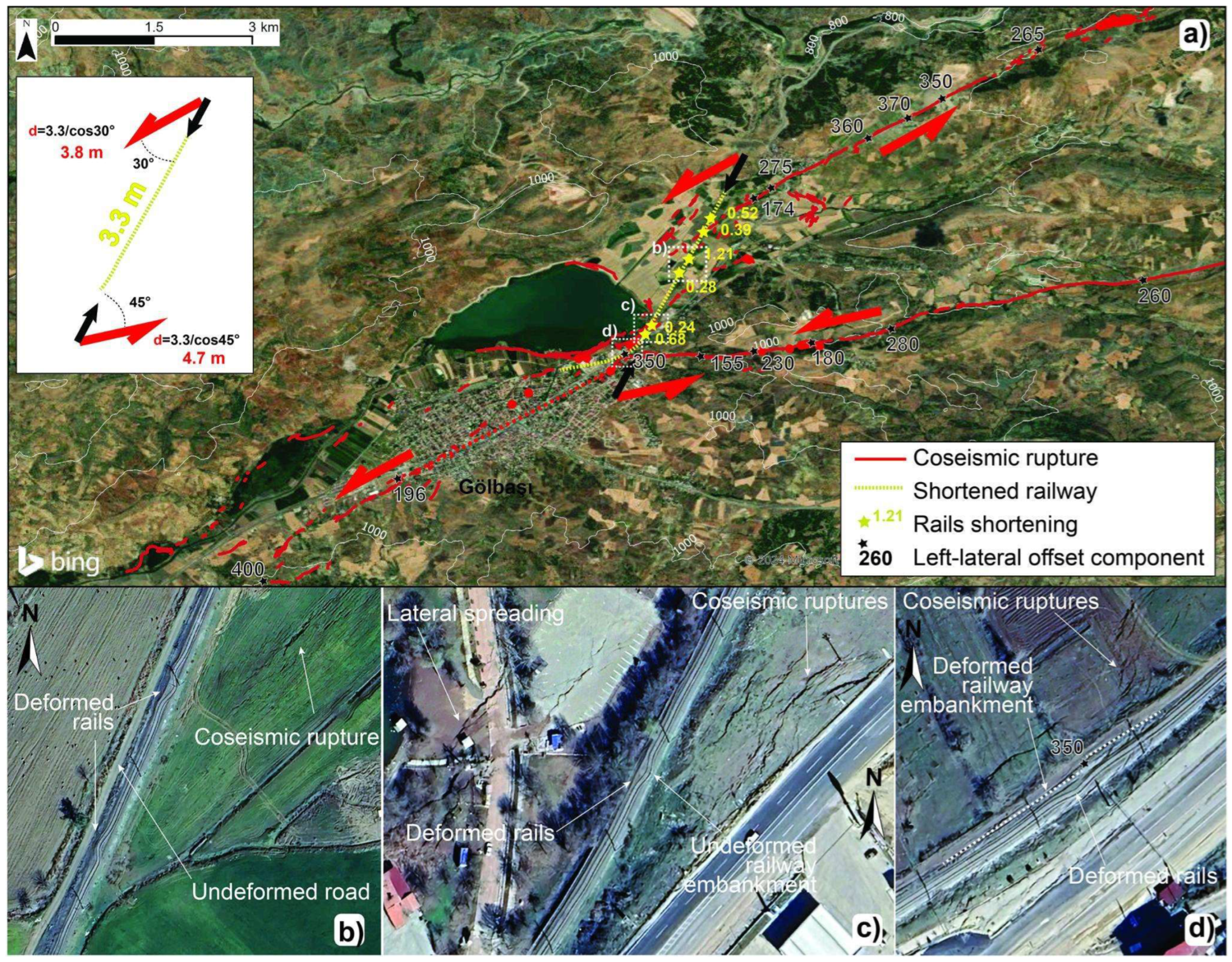
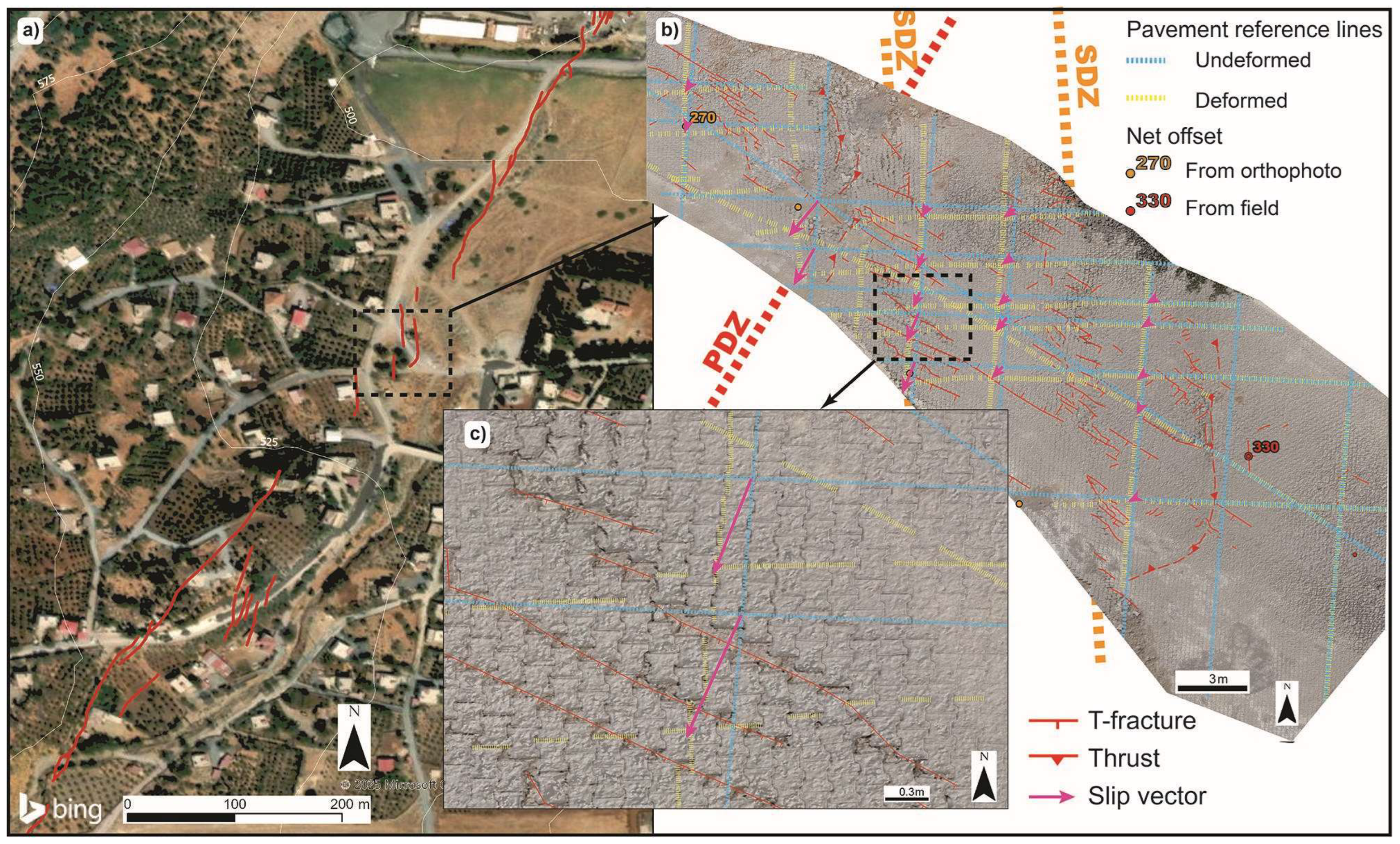
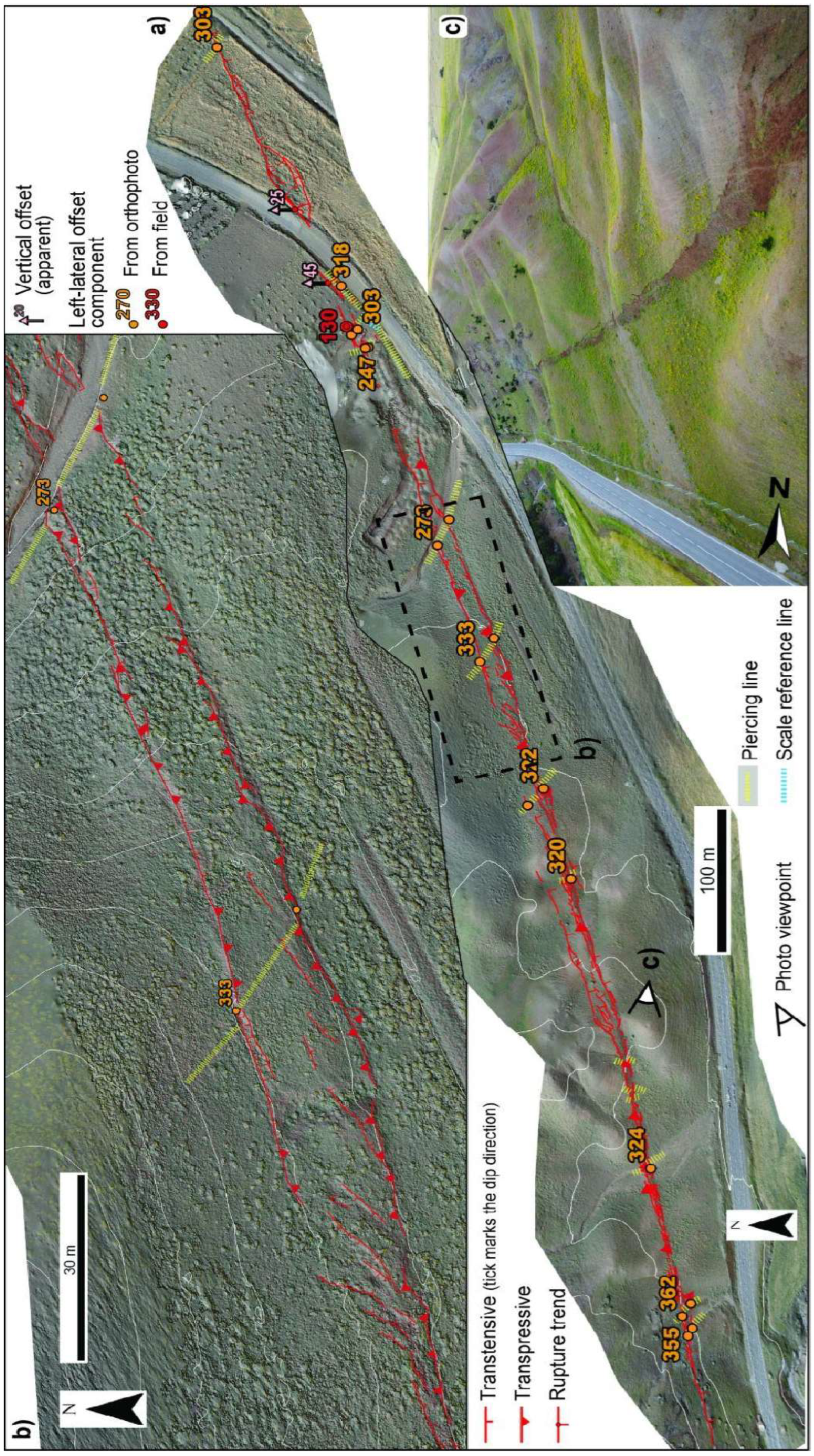
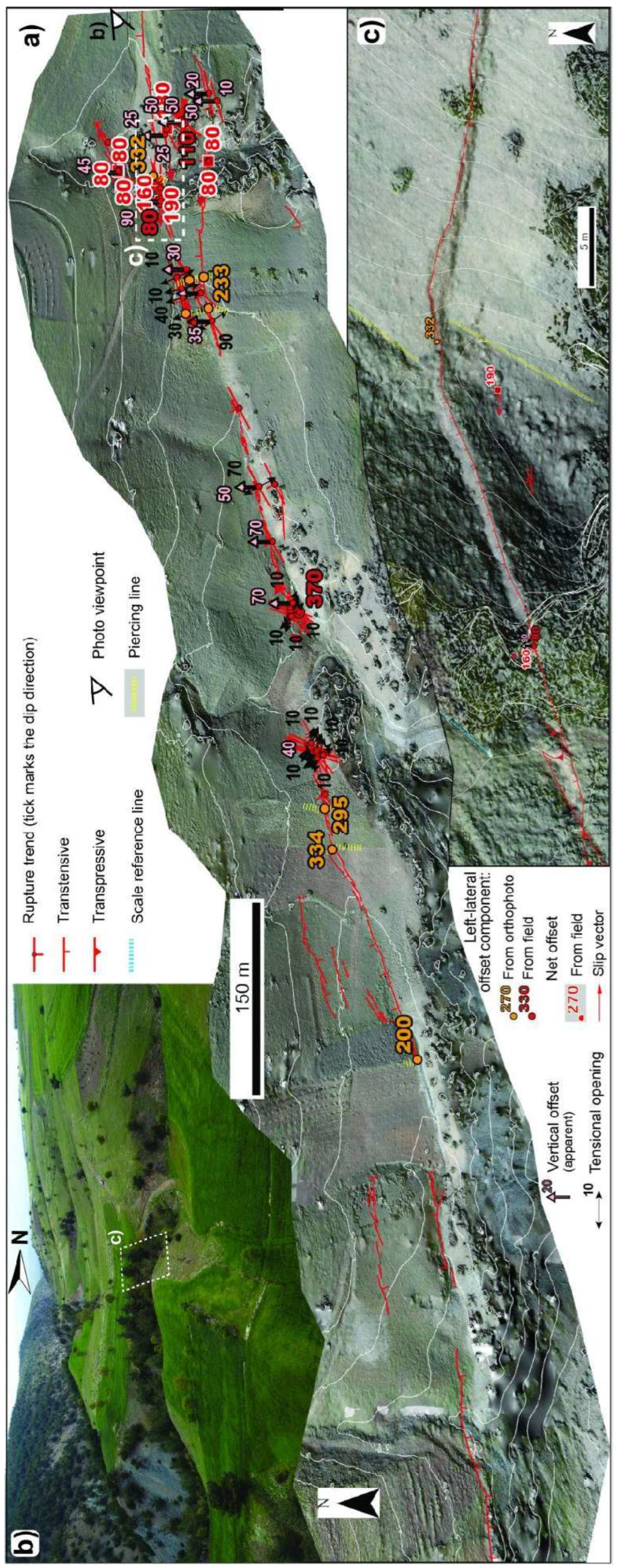

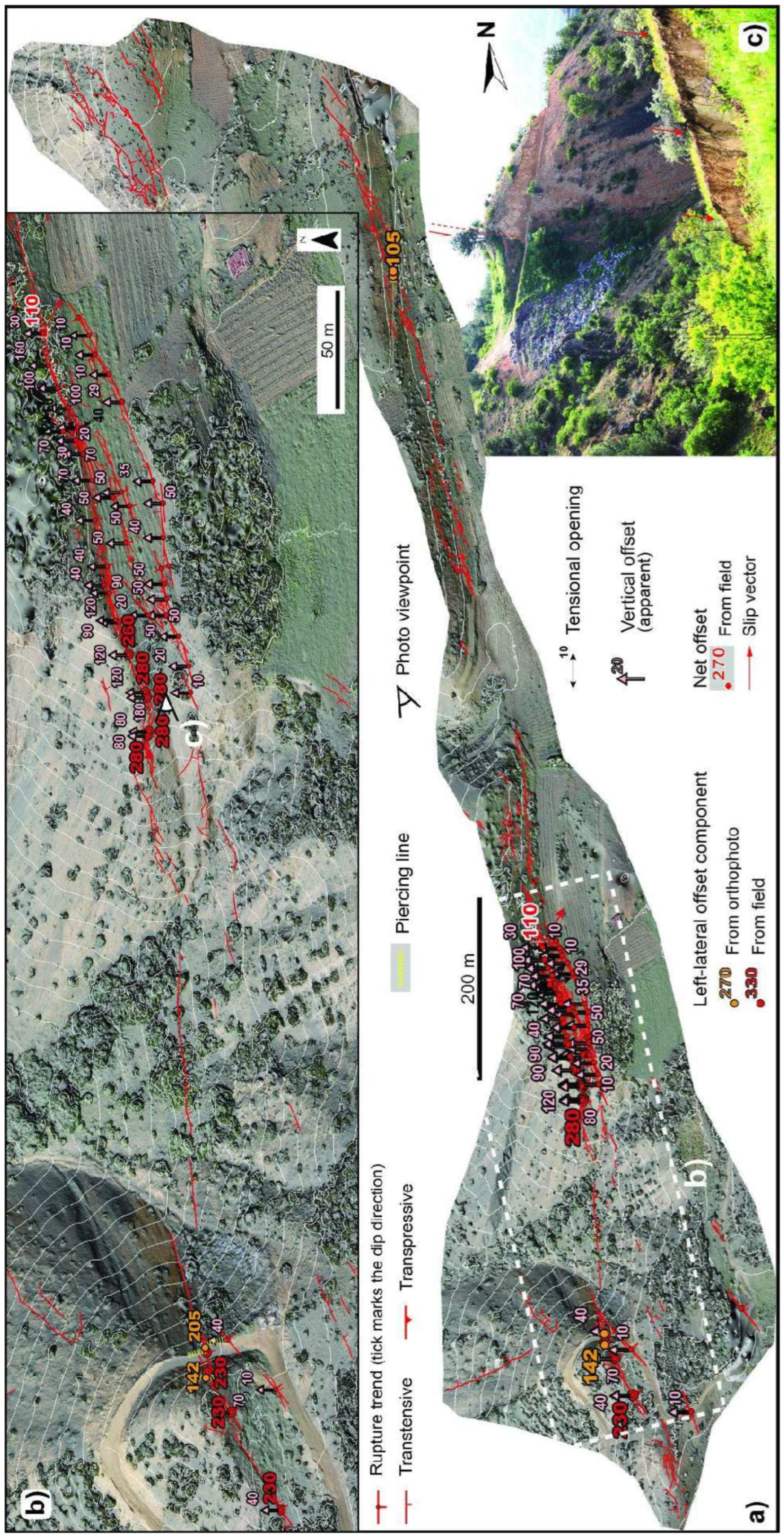


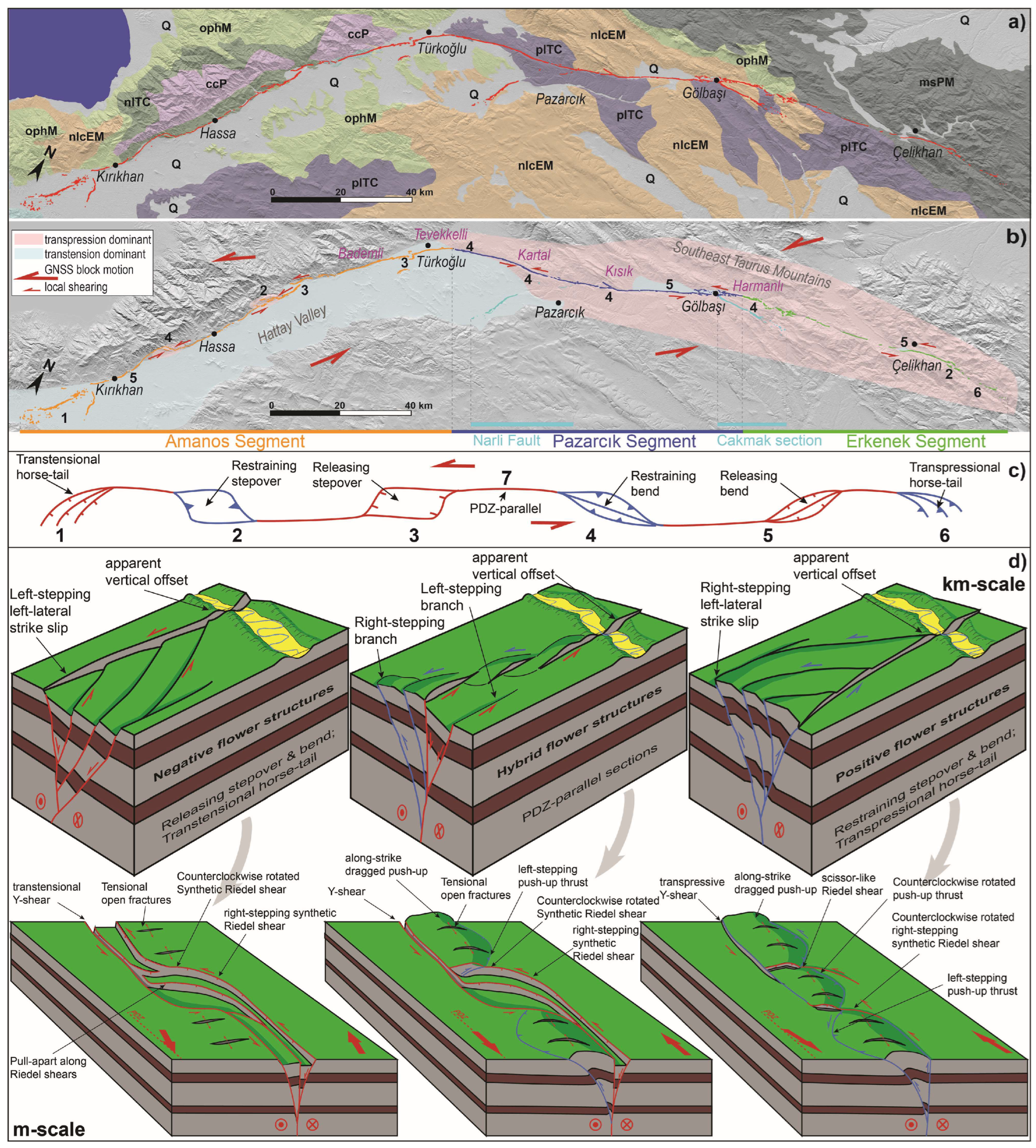
Disclaimer/Publisher’s Note: The statements, opinions and data contained in all publications are solely those of the individual author(s) and contributor(s) and not of MDPI and/or the editor(s). MDPI and/or the editor(s) disclaim responsibility for any injury to people or property resulting from any ideas, methods, instructions or products referred to in the content. |
© 2025 by the authors. Licensee MDPI, Basel, Switzerland. This article is an open access article distributed under the terms and conditions of the Creative Commons Attribution (CC BY) license (https://creativecommons.org/licenses/by/4.0/).
Share and Cite
Pucci, S.; Caciagli, M.; Azzaro, R.; Di Manna, P.; Blumetti, A.M.; Poggi, V.; De Martini, P.M.; Civico, R.; Nappi, R.; Ünsal, E.; et al. Examples of Rupture Patterns of the 2023, Mw 7.8 Kahramanmaraş Surface-Faulting Earthquake, Türkiye. Geosciences 2025, 15, 252. https://doi.org/10.3390/geosciences15070252
Pucci S, Caciagli M, Azzaro R, Di Manna P, Blumetti AM, Poggi V, De Martini PM, Civico R, Nappi R, Ünsal E, et al. Examples of Rupture Patterns of the 2023, Mw 7.8 Kahramanmaraş Surface-Faulting Earthquake, Türkiye. Geosciences. 2025; 15(7):252. https://doi.org/10.3390/geosciences15070252
Chicago/Turabian StylePucci, Stefano, Marco Caciagli, Raffaele Azzaro, Pio Di Manna, Anna Maria Blumetti, Valerio Poggi, Paolo Marco De Martini, Riccardo Civico, Rosa Nappi, Elif Ünsal, and et al. 2025. "Examples of Rupture Patterns of the 2023, Mw 7.8 Kahramanmaraş Surface-Faulting Earthquake, Türkiye" Geosciences 15, no. 7: 252. https://doi.org/10.3390/geosciences15070252
APA StylePucci, S., Caciagli, M., Azzaro, R., Di Manna, P., Blumetti, A. M., Poggi, V., De Martini, P. M., Civico, R., Nappi, R., Ünsal, E., & Tatar, O. (2025). Examples of Rupture Patterns of the 2023, Mw 7.8 Kahramanmaraş Surface-Faulting Earthquake, Türkiye. Geosciences, 15(7), 252. https://doi.org/10.3390/geosciences15070252










